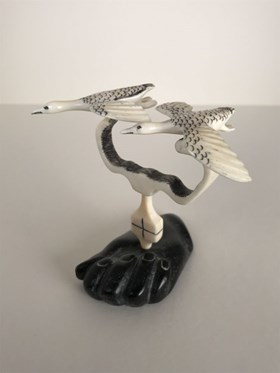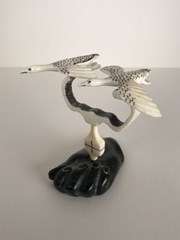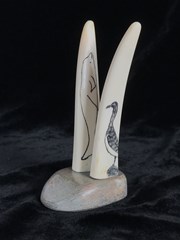Narrow Results By
- Artist
- Ping
- Date
- prior to 1962
- Catalogue Number
- PiN.06.01 a-e
- Description
- A five piece assembled sculpture of 2 flying birds. (a) base 2.0x8.0x4.1, black stone. Hand turned palm up with fingers clenched, fingernails carved in. Hole drilled in palm. (b) ivory support 4.6x1.5x.7. Centre has black cross both sides (c) support, ivory 4.0x6.0x.9, in shape of a w. Hole …
1 image
- Artist
- Ping
- Title
- Untitled
- Date
- prior to 1962
- Description
- A five piece assembled sculpture of 2 flying birds. (a) base 2.0x8.0x4.1, black stone. Hand turned palm up with fingers clenched, fingernails carved in. Hole drilled in palm. (b) ivory support 4.6x1.5x.7. Centre has black cross both sides (c) support, ivory 4.0x6.0x.9, in shape of a w. Hole in centre bottom, round pegs at top each end. One broken off (stuck inside bird) (d) flying bird, ivory, 1.5x5.0x6.0. Head and wings outstretched, webbed feet, pointed backwards. Carved wing feathers and tail. Black 'arches' design simulate feathers on back and wings. Black eyes. Hole in belly. (e) bird, ivory, 1.3x5.5x5.7, same as (d) Top of peg (c) broken off in hole in belly.
- Subject
- birds
- mythological
- hand
- flying
- Credit
- Gift of Doreen Hutchinson, Calgary, 1988
- Catalogue Number
- PiN.06.01 a-e
Images
This material is presented as originally created; it may contain outdated cultural descriptions and
potentially offensive content.
Read more.
- Artist
- Sila
- Date
- prior to 1962
- Catalogue Number
- SiL.06.01 a-c
- Description
- Two ivory tusks 9.0 cm long with engravings all sides of some arctic animals and birds. Holes in bottom have wood stick to place the tusks together on a stone base. The base is shaped with a flat bottom.a) White ivory (antler bone?), tusk-like form with rounded wooden peg inserted at its base. On…
1 image
- Artist
- Sila
- Title
- Untitled
- Date
- prior to 1962
- Dimensions
- 10.7 x 4.3 x 5.6 cm
- Description
- Two ivory tusks 9.0 cm long with engravings all sides of some arctic animals and birds. Holes in bottom have wood stick to place the tusks together on a stone base. The base is shaped with a flat bottom.a) White ivory (antler bone?), tusk-like form with rounded wooden peg inserted at its base. One side depicts a black bird with a white belly. It is standing on a black rounded form. Short mark-making techniques are used to depict texture in the birds body and on the form it stands upon. On the reverse side, a bear is outlined in black, with small strokes depicting a hair-like texture. The bear is laying down on the ground, nose pointed towards a small mound with a black hole on top. Dimensions 9.5cm x 2.7cm, tapering to 1.6 cm, by 1.0 cm tapering to 0.4cm. b) White ivory (bone?), tusk-like form with rounded wooden peg inserted at its base. One side depicts a whale (beluga?) outlined in black, with a line drawn from its belly around to the other side of the object. On the reverse, two black creatures are seen (fish? whales? seals?). The line connects from the previous whale to one of the creatures who had an oval body and two limbs, reach with four lines (claws? toes? fingers?) while the other creature, more whale like in appearance, faces away. Both creatures are coloured in black with thin strokes. Dimensions 9.5cm x 2.7cm, tapering to 1.6 cm, by 1.0 cm tapering to 0.4cm. c) Grey, orange and brown stone base. One end is rounded while the other is a soft square. It is mostly flat, with the rounded end tapering into a slope. There are two holes drilled into the top surface. The base has some areas that are rectangular and dark - perhaps stickers were once here. Dimensions 5.6cm x 4.3 cm x 0.8cm.
- Credit
- Gift of Doreen Hutchinson, Calgary, 1988
- Catalogue Number
- SiL.06.01 a-c
Images
This material is presented as originally created; it may contain outdated cultural descriptions and
potentially offensive content.
Read more.




